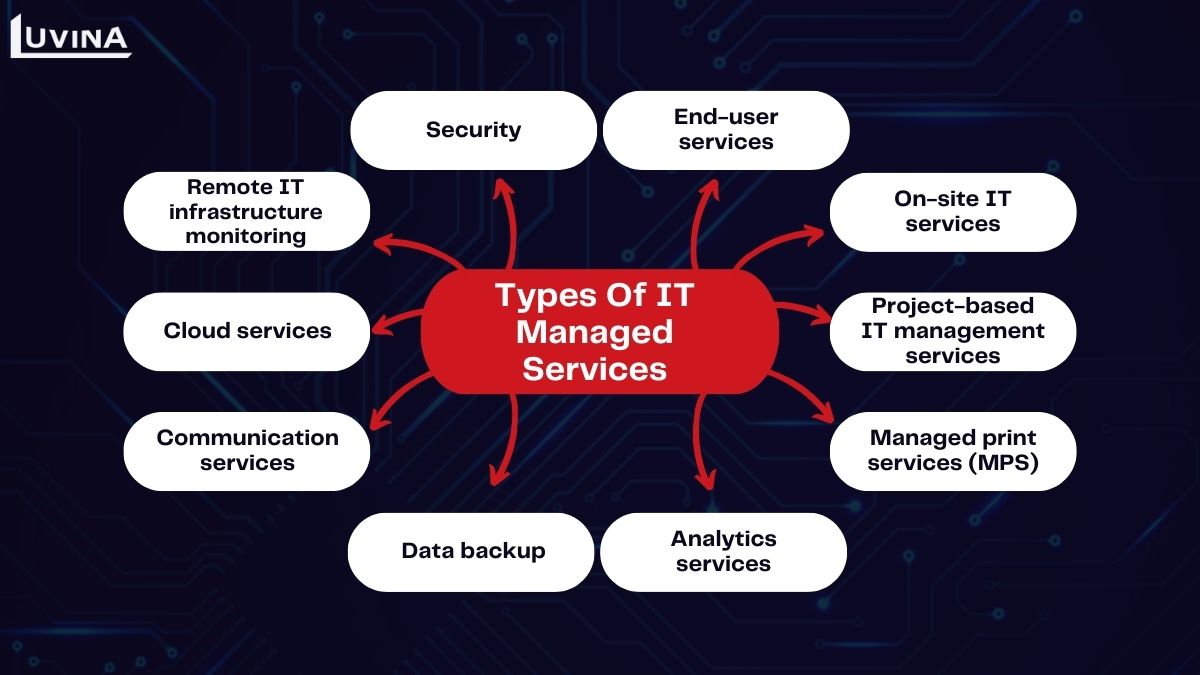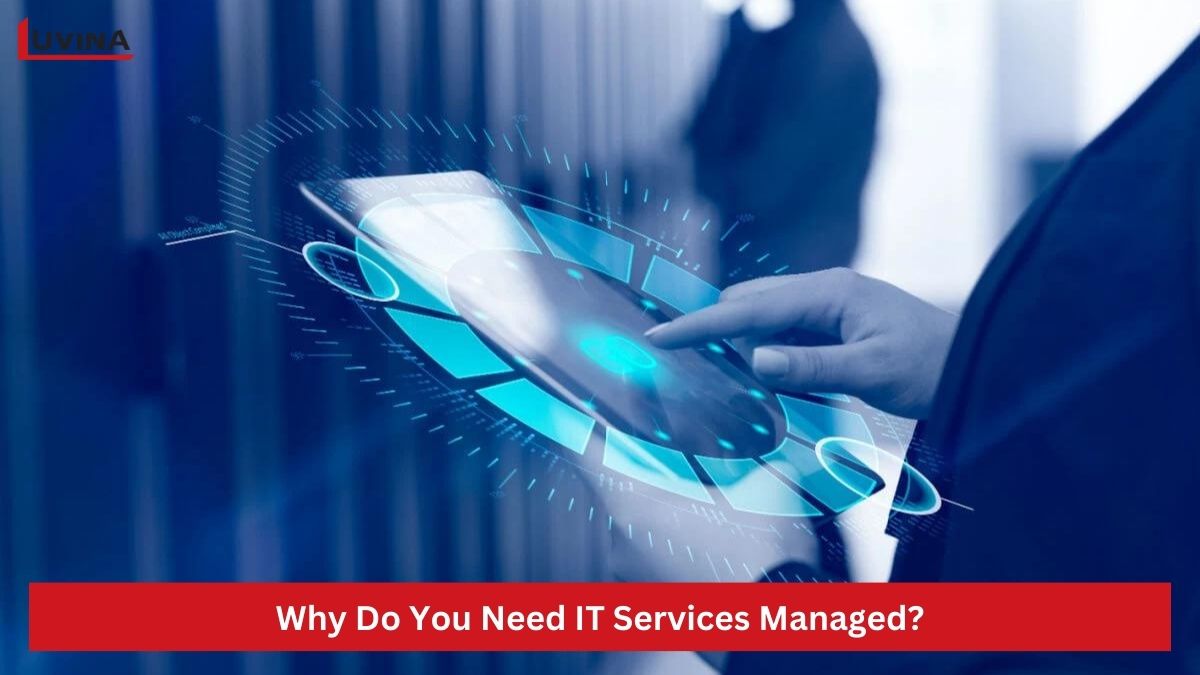Whether you are managing a startup or a large business, IT managed services can make your work easier by leveraging IT resources to reduce the workload of internal tasks or fill skill gaps. However, to maximize the effectiveness of managed IT services, you need to not only understand them well but also know how to choose the right service provider who can help improve your business operations. In the article below, let’s clarify what fully managed IT is, its benefits, and provide detailed guidance on how to select a potential managed IT service provider.
What is an IT Managed Service?
Managed IT services (IT services managed) are a type of IT outsourcing where service providers help businesses and organizations carry out specific IT tasks under a service contract or subscription. IT-managed services help businesses reduce the workload of their internal IT teams or provide skills that the internal team may be lacking.

With fully managed IT services, providers can support businesses in performing IT tasks 24/7 while also offering advice and expertise that the business needs. Managed IT services typically include remote monitoring and management of infrastructure, security, incident monitoring, cloud service management, communication support, and more.
Types of managed service
Based on the services provided, managed services can be divided into 10 basic types below:

- IT infrastructure monitoring: This is one of the most common types of IT services managed, involving the remote management of servers, workstations, and mobile devices.
- Security: To meet customer needs for data and IT system security support, service providers offer solutions, establish security strategies, or collaborate with other security companies to provide outsourced cybersecurity solutions.
- Helpdesk & Tech Support Service: Service providers help businesses swiftly address specific issues in their field by leveraging specialized technological expertise.
- On-site IT services: Service providers assign experts to specific locations to carry out various IT activities such as equipment maintenance, device installation, and site assessments.
- Cloud services: This service includes solutions like consulting, evaluation, and cloud management.
- Communication services: Many businesses today use fully managed IT services to manage communication systems. Solutions in this service may include integrating various telephone, multimedia communications, and data management into a unified center.
- Analytics services: Managing, collecting, evaluating, and protecting user and customer data. Some providers offer more specialized services such as market analysis and human analysis.
- Managed print services (MPS): Remote monitoring of printing activities, support for updates and repairs as needed, especially if the business has large printing needs.
- Data backup: Includes cloud data backup solutions, disaster recovery planning in case of data loss, and data recovery.
Benefits of managed IT service
IT services managed are beneficial for businesses of all sizes, whether large or small, established or startups. Here are some benefits that this type of IT outsourcing can bring to businesses:
- Clear, reliable service contracts: When partnering with managed IT service providers, you can set multiple terms of contracts for various IT tasks. These providers are responsible for fulfilling their obligations according to the Service Level Agreement (SLA). This ensures businesses can track progress without having to manage full-time employees.
- High efficiency: Outsourcing IT tasks allows businesses to focus on core business activities. Additionally, service providers can guide or suggest methods to optimize infrastructure, improve productivity, and increase ROI.

- Optimized uptime: IT service providers are not bound by the same schedules as your other employees. They can work outside regular business hours with a flexible schedule, ensuring more working hours and fewer interruptions in the process.
- Filling skill gaps: IT-managed services are ideal for businesses that lack the time or expertise to manage certain IT functions. By using managed IT services, your internal team can focus on core business activities and innovation without getting bogged down by everyday tasks.
- Cost savings: IT services managed to help you save significantly on training and hiring new staff. All costs are clearly outlined in the contract, making it easier to predict and plan your budget.
Steps to choosing the right managed IT service firms
IT services managed providers can bring many benefits to organizations and businesses, provided that the business chooses the right provider from the start. When selecting a fully managed IT services provider, you should choose companies with a good track record in the field. They should be able to develop strategic IT plans and take responsibility for the IT tasks you require.
To select the right IT-managed services partner, you can follow these steps:
Step 1: Evaluate your current IT system
Understand the infrastructure and workflows you are managing. Identify the resources you currently have and your budget for management. During this process, clearly define your business goals. This information will help you narrow down providers with the right experience, skills, and costs.
Step 2: System check by potential providers
Once you have narrowed down your options, ask the shortlisted service providers to check your system. This process will help you determine if they have the capability, experience, and equipment to support and manage your system. It will also ensure that they are familiar with industry standards. If they have difficulties in assessing your system, they might not be the right fit.

Step 3: Evaluate scalability and flexibility
When choosing a service provider, ensure that they can scale according to your needs and have expertise beyond your current requirements. Otherwise, the provider might decrease your business’s efficiency. Especially if you plan to change your infrastructure in the near future, carefully evaluate the flexibility and scalability of the IT services managed provider.
>> Also read: Managed IT Services Cost: Essential Insights Explained
Conclusion
As the pace of digital transformation accelerates and IT infrastructure develops, IT services managed are essential for all businesses. We hope this article has helped you understand IT-managed services and how to choose the right fully managed IT services provider.
If you are looking for a reliable IT services managed company, contact Luvina. With over 20 years of experience in providing IT outsourced managed IT services to businesses of all sizes, Luvina believes it can meet all your needs. Some of the managed IT services that Luvina offers include software development, system maintenance, system operations, on-site development, and more.
We have a team of over 750 highly skilled IT professionals who can communicate fluently in both English and Japanese and are ready to provide continuous 24/7 support regardless of time zone. Contact Luvina now to experience high-quality services certified with ISO 9001 and CMMI Level 3.









Read More From Us?
Sign up for our newsletter
Read More From Us?
Sign up for our newsletter